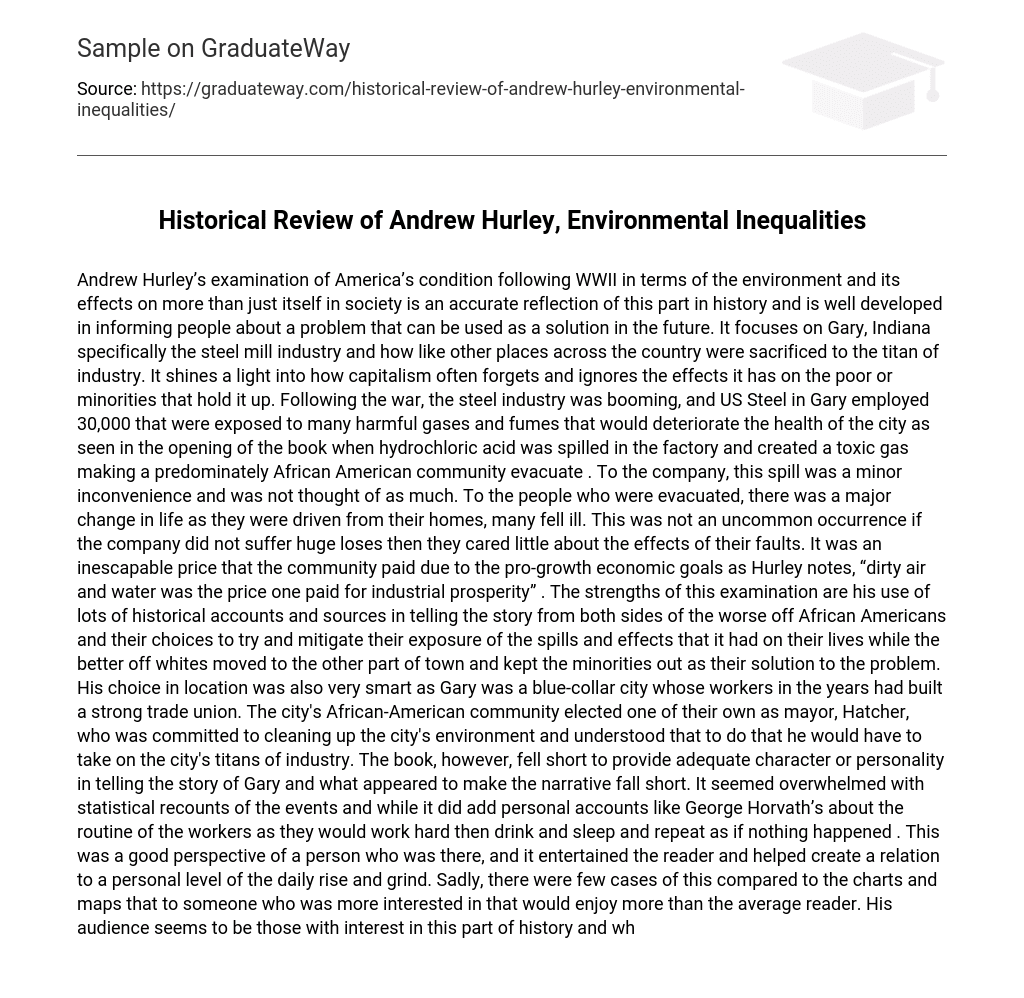Andrew Hurley’s examination of America’s condition following WWII in terms of the environment and its effects on more than just itself in society is an accurate reflection of this part in history and is well developed in informing people about a problem that can be used as a solution in the future. It focuses on Gary, Indiana specifically the steel mill industry and how like other places across the country were sacrificed to the titan of industry. It shines a light into how capitalism often forgets and ignores the effects it has on the poor or minorities that hold it up. Following the war, the steel industry was booming, and US Steel in Gary employed 30,000 that were exposed to many harmful gases and fumes that would deteriorate the health of the city as seen in the opening of the book when hydrochloric acid was spilled in the factory and created a toxic gas making a predominately African American community evacuate . To the company, this spill was a minor inconvenience and was not thought of as much. To the people who were evacuated, there was a major change in life as they were driven from their homes, many fell ill. This was not an uncommon occurrence if the company did not suffer huge loses then they cared little about the effects of their faults. It was an inescapable price that the community paid due to the pro-growth economic goals as Hurley notes, “dirty air and water was the price one paid for industrial prosperity” . The strengths of this examination are his use of lots of historical accounts and sources in telling the story from both sides of the worse off African Americans and their choices to try and mitigate their exposure of the spills and effects that it had on their lives while the better off whites moved to the other part of town and kept the minorities out as their solution to the problem. His choice in location was also very smart as Gary was a blue-collar city whose workers in the years had built a strong trade union. The city’s African-American community elected one of their own as mayor, Hatcher, who was committed to cleaning up the city’s environment and understood that to do that he would have to take on the city’s titans of industry. The book, however, fell short to provide adequate character or personality in telling the story of Gary and what appeared to make the narrative fall short. It seemed overwhelmed with statistical recounts of the events and while it did add personal accounts like George Horvath’s about the routine of the workers as they would work hard then drink and sleep and repeat as if nothing happened . This was a good perspective of a person who was there, and it entertained the reader and helped create a relation to a personal level of the daily rise and grind. Sadly, there were few cases of this compared to the charts and maps that to someone who was more interested in that would enjoy more than the average reader. His audience seems to be those with interest in this part of history and who want to see more environmental justice and would like to be more informed on this. this account by Hurley does well in providing strong arguments and accurate accounts of this time, it could quickly become a standard for people in the field of environmental justice. The sources that Hurley used are broad but work well to recount the story of Gary, in the footnote’s pages at the end of the book house all the sources used throughout. Within the same page on 102, Hurley smoothly and effectively transitions from using an interview with a member of Lake County Fish and Game Association to statistics from the US Department of the Interior on pollution in Lake Michigan and then into a newspaper article from the Gary Post-Tribune . Normally you would not see such varying mediums of knowledge being used intertwined so well and not leaving you confused or bored. They all intersect on the issue he is arguing about, that is congruent through the paper, how industry and capitalism will trump the environment and its people for economic growth. These are all accurate and reliable sources and are appropriate for the way Hurley intends to recount this story. This book is thoroughly researched, well written, and is a compelling story of how industry rolls over the ones that keep it a well-oiled machine as well as the environment that gives it its resources like they are not even there. I would recommend this book to anyone who is interested in cities, social justice, the ecosystem, or just feel like picking up something that is not really like anything you have read before.
Historical Review of Andrew Hurley, Environmental Inequalities
Cite this page
Historical Review of Andrew Hurley, Environmental Inequalities. (2021, Sep 21). Retrieved from
https://graduateway.com/historical-review-of-andrew-hurley-environmental-inequalities/





